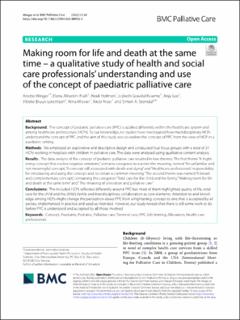| dc.contributor.author | Winger, Anette | |
| dc.contributor.author | Albertini Früh, Elena | |
| dc.contributor.author | Holmen, Heidi | |
| dc.contributor.author | Kvarme, Lisbeth Gravdal | |
| dc.contributor.author | Lee, Anja | |
| dc.contributor.author | Bruun Lorentsen, Vibeke | |
| dc.contributor.author | Misvær, Nina | |
| dc.contributor.author | Riiser, Kirsti | |
| dc.contributor.author | Steindal, Simen Alexander | |
| dc.date.accessioned | 2022-04-13T07:32:17Z | |
| dc.date.available | 2022-04-13T07:32:17Z | |
| dc.date.created | 2022-04-12T10:10:40Z | |
| dc.date.issued | 2022 | |
| dc.identifier.issn | 1472-684X | |
| dc.identifier.uri | https://hdl.handle.net/11250/2991143 | |
| dc.description.abstract | Background:
The concept of pediatric palliative care (PPC) is applied differently within the healthcare system andamong healthcare professionals (HCPs). To our knowledge, no studies have investigated how multidisciplinary HCPsunderstand the concept of PPC and the aim of this study was to explore the concept of PPC from the view of HCP in apaediatric setting.
Methods:
We employed an explorative and descriptive design and conducted four focus groups with a total of 21
HCPs working in hospitals with children in palliative care. The data were analysed using qualitative content analysis.
Results:
The data analysis of the concept of pediatric palliative care resulted in two themes. The first theme “A frighteningconcept that evokes negative emotions,” contains categories to explore the meaning, named “An unfamiliar andnot meaningful concept, “A concept still associated with death and dying” and “Healthcare professionals’ responsibilityfor introducing and using the concept and, to obtain a common meaning.” The second theme was named “A broadand complementary concept,” containing the categories “Total care for the child and the family,” “Making room for lifeand death at the same time” and “The meaning of alleviation and palliative care.”
Conclusions:
The included HCPs reflected differently around PPC but most of them highlighted quality of life, total
care for the child and the child’s family and interdisciplinary collaboration as core elements. Attention to and knowledgeamong HCPs might change the perception about PPC from a frightening concept to one that is accepted by allparties, implemented in practice and used as intended. However, our study reveals that there is still some work to dobefore PPC is understood and accepted by all those involved. | en_US |
| dc.language.iso | eng | en_US |
| dc.rights | Navngivelse 4.0 Internasjonal | * |
| dc.rights.uri | http://creativecommons.org/licenses/by/4.0/deed.no | * |
| dc.subject | Palliativ sykepleie | en_US |
| dc.subject | Barnesykepleie | en_US |
| dc.title | Making room for life and death at the same time – a qualitative study of health and social care professionals’ understanding and use of the concept of paediatric palliative care | en_US |
| dc.title.alternative | Making room for life and death at the same time – a qualitative study of health and social care professionals’ understanding and use of the concept of paediatric palliative care | en_US |
| dc.type | Peer reviewed | en_US |
| dc.type | Journal article | en_US |
| dc.description.version | acceptedVersion | en_US |
| dc.description.version | publishedVersion | en_US |
| dc.source.journal | BMC Palliative Care | en_US |
| dc.identifier.doi | 10.1186/s12904-022-00933-4 | |
| dc.identifier.cristin | 2016901 | |
| cristin.ispublished | true | |
| cristin.fulltext | original | |
| cristin.fulltext | postprint | |
| cristin.qualitycode | 1 | |

